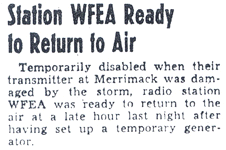


 |
 |
 |
| 1930s
| 1940s | 1950s
| 1960s | 1970s
| 1980s | 1990s
| 2000+ Blaw Knox tower | 1938 Hurricane | 75th Anniversary | Recollections | Music Surveys |
|
|
|
 |
When the wooden mast broke off I decided that we would get at least 350 feet away from the base of our big tower which is structural steel. Edna was with me at the time for which I am very thankful since it spared her a natural anxiety for my safety and no doubt indirectly saved her life. We got in our car and I drove to a nearby farmhouse to see if their telephone circuit might possibly yet be intact. The Merrimack operator answered indicating a clear line south but she had been unable to raise the Manchester operator. I emerged and dodging a rain of shingles from the barn roof reached the car. I later discovered a shingle forced half through one of the engine hood louvres. We started to drive towards Manchester - a few minutes after we left a huge elm crashed where the car had been parked. I had driven no more than a mile when we were blocked by another large elm with a three foot butt directly across the highway. There was nothing to do but return if possible to the transmitter field and stay in the clear. I turned around and started back. Some telephone poles were snapped and were swaying dangerously out over the road. I had driven a few hundred feet only when the canvas top of the convertible coupe ripped wide open leaving me staring up at the sky which was an odd brownish gray. Another half mile and yet another tree across the road; this one had come down behind us. It had split near the base and the portion not already down was swaying ominously over the road.
I drove into a yard and facing the storm watched the fate of the tree. It would apparently hold for a time and I decided to drive through the small top branches which just reached the opposite edge of the concrete. I wasted no time going by and the branches slapped us defiantly. |
|
 |
I was greatly worried about Edna but she survived the experience remarkably well. It was due, she says, to the fact that I appeared so matter of fact about it all. This allayed her very natural misgivings about the intensity of the wind and our danger. And my heart was in my throat all the time! I hope never to go through such an experience again. There is no describing of the havoc wrought. Ten years of normal timber cutting, down in two hours! It is a very real wrench at my love for woods and trees to see whole groves of stately pines twisted and torn out by the roots. Some fifty and seventy five years old and between two and three feet at the butt were either snapped off a few feet above the ground or were completely down. |
| 1930s
| 1940s | 1950s
| 1960s | 1970s
| 1980s | 1990s
| 2000+ Blaw Knox tower | 1938 Hurricane | 75th Anniversary | Recollections | Music Surveys |
| ©2004-2025 Man From Mars Productions |